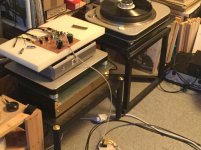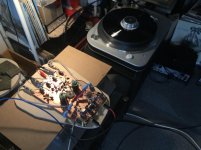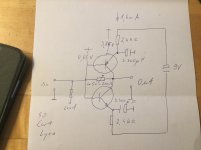No, I do not know. There are others with higher Hfe and slightly higher Rbb‘.
They could be paralleled for good use.
They could be paralleled for good use.
I moved the transformer to the floor. Hum gone, hiss very low.
Congratulations 🎈🎊🍾
Looking forward to listen to it and compare it with the one and only real 🐆 ( Jaguar)
Building constant current sources for better PSRR and less distortion.
What is the purpose of the big caps c4 and c5 in your schematic ?
An input BJT I would like to try is the ZXTN19020DG.
Although it has more voltage noise ( rbb‘ @ 10mA 6,8 Ohm ) then the champion ZTX851 ( rbb‘ @ 10mA 1,7 Ohm ) it has lower cob = 16pF instead of 45pF in the ZTX851, and double the beta ( Hfe ).
In comparison 6,7 mA in the ZTX851 created an en of 0,24 nV / root Hz and 1,6mA does 0,48 nV / root Hz in the ZXTN1920DG. So 4 in parallel of those would equal 1 ZTX851 with a caveat : cob will ad by a factor of 4 and here goes our speed advantage.
Nevertheless the beta advantage remains and that could help to reduce current into the cartridge by a factor of two in DC coupled stages with no bias cancellation.
Although it has more voltage noise ( rbb‘ @ 10mA 6,8 Ohm ) then the champion ZTX851 ( rbb‘ @ 10mA 1,7 Ohm ) it has lower cob = 16pF instead of 45pF in the ZTX851, and double the beta ( Hfe ).
In comparison 6,7 mA in the ZTX851 created an en of 0,24 nV / root Hz and 1,6mA does 0,48 nV / root Hz in the ZXTN1920DG. So 4 in parallel of those would equal 1 ZTX851 with a caveat : cob will ad by a factor of 4 and here goes our speed advantage.
Nevertheless the beta advantage remains and that could help to reduce current into the cartridge by a factor of two in DC coupled stages with no bias cancellation.
There is a complementary PNP, the ZXTP19020DG where I have no information about the noise. I assume that it is just as good as the NPN because PNPs are usually even better.
We could then make a parallel symmetric input stage with 1,6mA standing current that would result in 0,36nV / root Hz when I am not wrong and this is not too shabby.
The low idle current lends to battery supply and the cob advantage should remain.
We could then make a parallel symmetric input stage with 1,6mA standing current that would result in 0,36nV / root Hz when I am not wrong and this is not too shabby.
The low idle current lends to battery supply and the cob advantage should remain.
No, but there are lot of Zetex transistors that are useful for this purpose.
Here is the most simple circuit I could think of.
It is a John Curl design from the 70th.
You could also take out the feedback resistor and terminate the output with it.
You could call the first version shunt feedback and the second version a kind of Lokal current feedback. Some will say open loop.
Here is the most simple circuit I could think of.
It is a John Curl design from the 70th.
You could also take out the feedback resistor and terminate the output with it.
You could call the first version shunt feedback and the second version a kind of Lokal current feedback. Some will say open loop.
Attachments
Did CSS lower the noise?
Also have you tried 10R on the input ground? There's a natural loop that +/- supplies form. There is a way around it but it might get interesting for a phono device.
Also have you tried 10R on the input ground? There's a natural loop that +/- supplies form. There is a way around it but it might get interesting for a phono device.
What is the meaning of CSS ?
Ops I meant CCS. Constant current source.
Isn‘t a battery a current source in a way ?
Terminating the input.
That is the name of my next book.
Terminating the input.
That is the name of my next book.
Isn‘t a battery a current source in a way ?
Terminating the input.
That is the name of my next book.
Not really. They peak really hard wide open.


